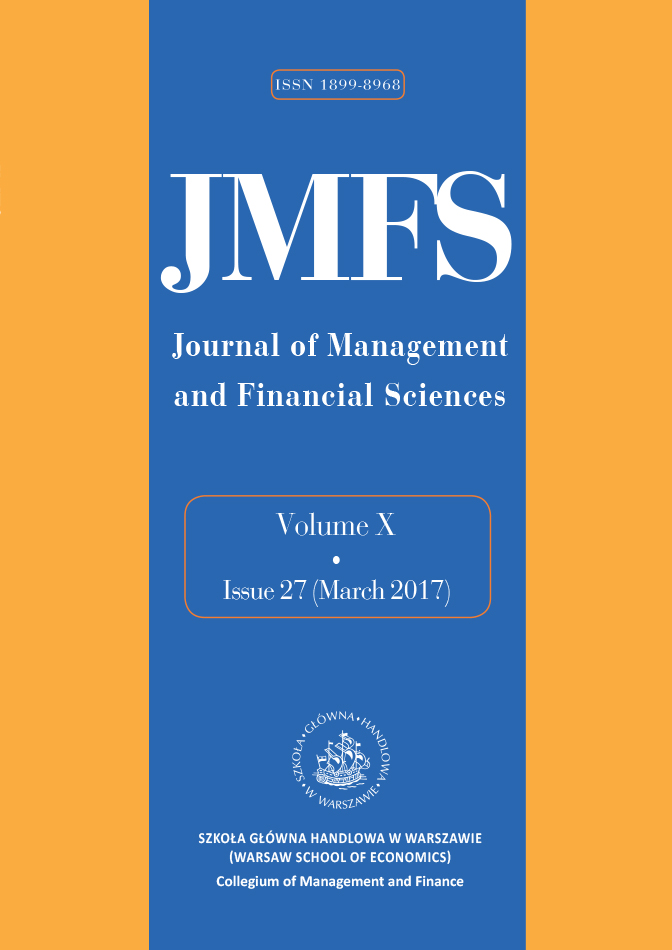FDI Inflow to Special Economic Zones in Poland Regional Approach
Main Article Content
Abstract
One of the ways to comńnce investors, in particular foreign ones, to participate in the pursuit of host country s economic policies leads through the development of Special Economic
Zones (SEZs), which are designed to offer business environment morę favourable than in other locations.
The SEZs, which have been established and developed in Poland, play a positive role in attracting foreign direct investment (FDI) or creating new jobs but they may also have negative conseąuences, such as deepening regional disproportions in the country.
This paper aims at examining whether location in a particular region (understood as a unit of administrative division of the country at the level of a voivodship) could be a factor
determining the inflows of foreign direct investment (FDI) to the SEZs. The study uses statistical methods (Spearmans rank correlation and Pearson correlation). Our calcula- tions have shown statistically significant positive relationships between FDI inflow to SEZs and coefficients that describe the attractiveness (collective and partial) and economic advancement of voivodships.
However, it seems that against hopes vested in them, SEZs do not reduce regional economic differentiation in Poland. The results may suggest the need to reconsider the so far applied policy designed to support investors. At the same time, they prove that State interference intended to mitigate market imperfections may itself become the source thereof.
Downloads
Article Details
References
2. Acocella N., Zasady polityki gospodarczej. Wartości i metody analizy, Polish Scientific Publishers, Warsaw 2002.
3. Act amending the Act on SEZ, 2003. Act amending the Act on Special Economic Zones of 2003, Polish Oflicial fournal of 2003, no. 188, item. 1840.
4. Act on Special Economic Zones, 1994, Polish Oflicial fournal of 1994, no. 123, item. 600 with further amendments.
5. Atrakcyjność inwestycyjna województw i podregionów Polski 2014, ed. M. Nowicki, Instytut Badań nad Gospodarką Rynkową, Gdańsk 2014.
6. Ambroziak A., Krajowa pomoc regionalna w specjalnych strefach ekonomicznych w Polsce, Warsaw School of Economics Publishing House, Warsaw 2009.
7. Balcerowicz L., 800 dni. Szok kontrolowany, Polska Oficyna Wydawnicza “BGW”, Warsaw 1992.
8. Ciżkowicz P, Ciżkowicz-Pękała M., Pękała P, Rzońca A., The Effects ofSpecial Economic Zones on Employment and Imestment: Spatial Panel Modelling Perspective, NBP Working Paper no. 208, Economic Institute, Warsaw 2015.
9. Consolidated version of the Treaty on the Functioning of the European Union (TFEU), 30 March 2010, Oflicial fournal of the European Union, vol. 53.
10. Dorożyński T., Świerkocki ]., Urbaniak, W., The Location Premises ofFDI in Poland. The Case of the Lodź Province, “Comparative Economic Research. Central and Eastern Europę” 2015, vol. 18, no. 4.
11. Dynamika transformacji polskiej gospodarki, eds. M. Belka, W. Trzeciakowski, Poltext, Warsaw 1997.
12. Information about the Implementation ofthe Act on Special Economic Zones, Ministry of Economy, Warsaw 2015.
13. Imestment Incentives in SEZ, Polish Information and Foreign Investment Agency, Warsaw 2015, www.paiz.gov.pl
14. Litwack ]., Qian Y., Balanced or Unbalanced Development: Special Economic Zones as Catalysts for Transition, “Journal of Comparative Economics” 1998, no. 26(1).
15. Markowski R., Tworzecki H., Czar silnej ręki, “Polityka” 2016, no. 10(3049).
16. Meier G., The International Emironment of Business. Competition and Governance in the Global Economy, Oxford University Press, New York 1998.
17. Ocena efektywności funkcjonowania specjalnych stref ekonomicznych w Polsce, ed. R. Pastusiak, University of Lodź, Lodź 2013.
18. Pastusiak R., Specjalne strefy ekonomiczne jako stymulator rozwoju gospodarczego, University of Lodź, Lodź 2011.
19. Political Priority, Economic Gamble, “The Economist”, April 4th, 2015.
20. Pomoc publiczna udzielona w latach 2006-2010 przedsiębiorcom działającym w specjalnych strefach ekonomicznych. Informacja o wynikach kontroli, Najwyższa Izba Kontroli, 2012.
21. Reforming International Imestment Governance, World Investment Report 2015, UNCTAD, 2015.
22. Regional GDP GDP Per Capita in the EU in 2013: Seven Capital Regions Among the Ten Most Prosperous, Eurostat, 2015.
23. Regulation of the Council of Ministers, 2014. Regulation of the Council of Ministers of 30.06.2014 on the regional aid map 2014-2020, Polish Official Journal of 2014, item. 878.
24. Rószkiewicz M., Metody ilościowe w badaniach marketingowych, Polish Scientilic Publishers, Warsaw 2002.
25. Sobczyk M., Statystyka. Podstawy teoretyczne przykłady - zadania, Wydawnictwo UMCS, Lublin 2000.
26. Specjalne strefy ekonomiczne po 2020 roku. Analiza dotychczasowej działalności i perspektywy funkcjonowania, Ernst&Young, 2011.
27. Statistical Yearbook of the Regions - Poland 2015, GUS, Table 276.
28. Warr R, Export Processing Zones: The Economics ofEnclave Manufacturing, “World Bank Research Observer, World Bank Group” 1989, vol. 4(1).
29. World Economic Outlook: Adjusting to Lower Commodity Prices, IMF, October 2015.
